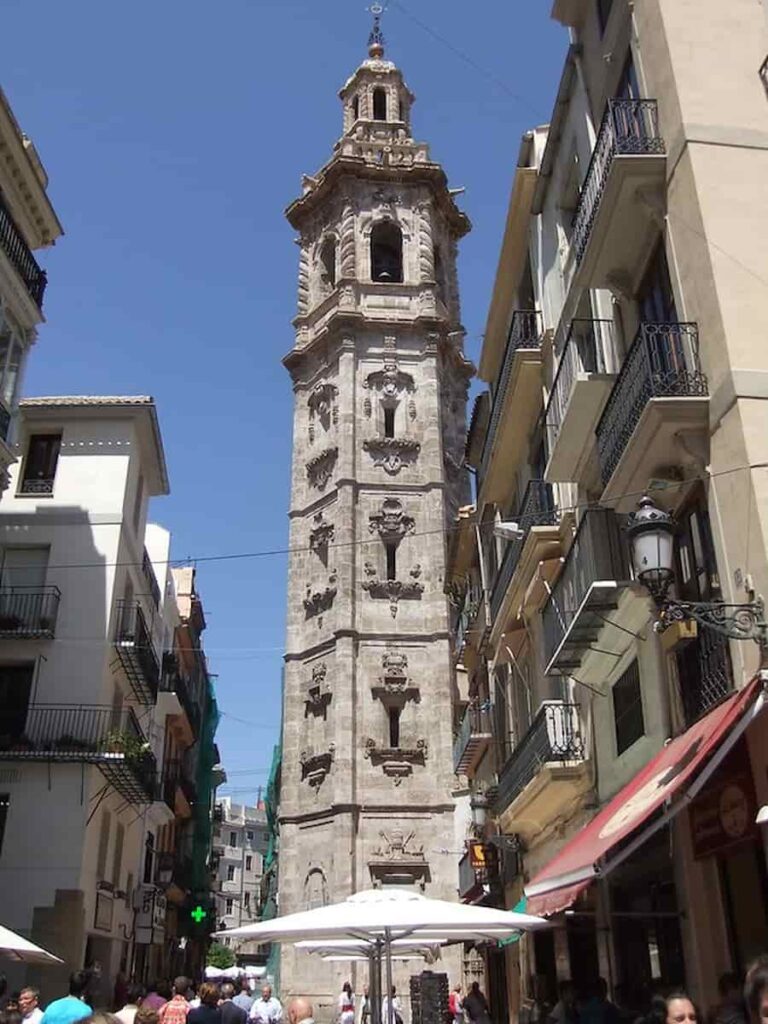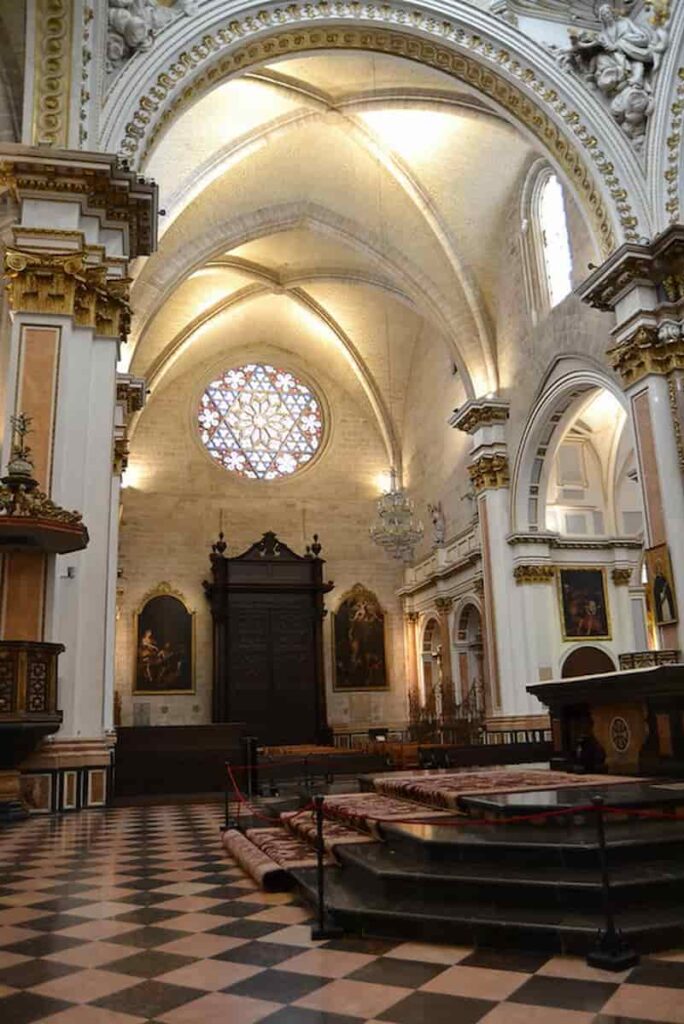Valencia Cathedral: The Holy Grail, Miguelete + More

Valencia Cathedral is one of the most iconic landmarks in the Spanish city of Valencia. Located in the heart of the city’s old town, it’s easily accessible for tourists and locals alike.
Construction of the Valencia Cathedral began in the 13th century, and it took almost 300 years to complete. Because of this, the cathedral is a mix of Gothic, Romanesque, and Baroque styles, which is evident in its intricate details and ornate decorations.
But did you know that the Cathedral was built on the site of what was actually a former Visigothic cathedral…which was later turned into a mosque by the Moors? And that, eventually, it ended up with what may well be one of the most sacred items in Christianity?
Keep reading to learn about this fascinating history and how it comes through with what you can see today.

Why is the Valencia Cathedral famous?
One of the main reasons why the Valencia Cathedral is so famous is because of its stunning architecture. However, its religious significance in holding what is thought to be the Holy Grail, one of the most important Christian relics in the world, has also made it well known.
As I’ll go into further below, the Cathedral was built over the course of several centuries, and it features a unique blend of Gothic, Baroque, and Romanesque styles. The cathedral’s most notable feature is its Miguelete Tower, which stands at an impressive 207 feet tall and offers breathtaking views of Valencia’s Old Town.
All of these make it a notable part of the Valencian skyline and, when combined with its importance from a religious perspective, make it clear why you should visit the Cathedral during your time in the city.
Is Valencia Cathedral Worth Visiting?
If you’re planning a trip to Valencia, the Cathedral is an absolute must-see. It’s one of the most iconic landmarks in the city, and is steeped in history and culture. The Cathedral is located in the heart of the city, so it’s easy to get to and is surrounded by other attractions.
As mentioned above, one of the highlights of the Cathedral is the Miguelete Tower. You can climb to the top of the tower and enjoy panoramic views of Valencia, including into the oldest part of the city, Valencia’s El Carmen neighborhood.
The climb is steep, but it’s worth it for the stunning views. The tower is also a great place to take photos, so be sure to bring your camera.

Then, once you get inside the Cathedral, you’ll find a wealth of art and architecture. The Gothic style of the building is breathtaking, and the intricate details are truly impressive.
And just to reiterate the point from earlier: The Cathedral is also home to what is considered to be the Holy Grail, which is said to be the cup that Jesus used at the Last Supper. This is a fascinating piece of history, and is definitely worth seeing.
Is Valencia Cathedral Free?
Entry to Valencia Cathedral is free, although donations are welcome. There is, however, a fee to enter the Valencia Cathedral Museum and to climb the Miguelete bell tower. Discounts are available for certain people though, including if you have the Valencia Tourist Card.
At the time of writing this, general entry to the Museum is EUR 9 and to climb the tower is EUR 2.50. Check the Cathedral’s website for up to date pricing and opening hours before heading there though to ensure these are still accurate.
What is the nearest metro to Valencia Cathedral?
If you’re planning to visit Valencia Cathedral, you’ll be pleased to know that it’s easily accessible by metro. The nearest metro stations to the cathedral are Colón and Alameda, both of which are located on Line 3 (Red Line) of the Valencia Metro system.
If you’re arriving in Valencia by train or bus, you can take the metro from Valencia Nord Station to Colón or Alameda. The journey takes around 10-15 minutes, depending on which station you choose.
Once you arrive at Colón or Alameda, it’s just a short walk to the cathedral, which is located in the heart of the city’s historic center. Its main entrance is at Plaza de la Reina but the entire structure actually continues until Valencia’s Plaza de la Virgen behind it.
If you’re staying in Valencia for a few days, it’s worth considering purchasing a Valencia Tourist Card, which includes unlimited travel on the metro, as well as discounts on attractions, restaurants, and shops.
The card is available for 24, 48, or 72 hours, and can be purchased online or at tourist information offices throughout the city.
History
You simply cannot visit Valencia without seeing the magnificent Valencia Cathedral. Built on the site of a former Visigothic cathedral that had been turned into a mosque by the Moors, the Valencia Cathedral was consecrated in 1238 by the first bishop of Valencia after the Reconquista, Pere d’Albalat, Archbishop of Tarragona. It was dedicated to Saint Mary by order of James I the Conqueror.
The Valencia Cathedral is a Gothic-style building that preserves many elements from different periods, from Romanesque to Baroque eras. Work on the current building began in the 13th century and continued for centuries.

As mentioned earlier, the cathedral was built over the site of the former Visigothic cathedral, which under the Moors had been turned into a mosque. The building was expanded and renovated over the years, with the addition of the bell tower in the 14th century and the dome in the 18th century.
The cathedral has seen many significant events throughout history. In 1462, a “burning” pigeon, representing the Holy Spirit, was coming down from the dome, and sparks shot out from it lighting fire the cloth around the wooden and silver altarpiece, burning the whole decoration of the apse and the paintings in fresco of the vault. The cathedral was also used as a prison during the Spanish Civil War.
Today, however, the cathedral is a popular tourist attraction and a symbol of Valencia’s rich history and culture.
Architecture
The cathedral’s architecture is a blend of various styles including Romanesque, French Gothic, Renaissance, Baroque, and Neoclassical. This combination has made this into one of the most iconic landmarks of Valencia and is a must-visit for anyone interested in architecture.
Exterior
The exterior of Valencia Cathedral is a stunning sight to behold. The most prominent feature of the exterior is the Miguelete Tower, which stands tall at 51 meters.
The tower is accessible via a spiral staircase of 207 steps, and the view from the top is breathtaking.
The Puerta del Palau is another notable feature of the exterior. It is the main entrance to the cathedral and features intricate carvings and sculptures.
Interior
The interior of Valencia Cathedral is equally impressive. The Ambulatory is a circular walkway that surrounds the main altar and is adorned with beautiful stained glass windows.
The Main Altar is a masterpiece of Gothic art and features intricate carvings and sculptures. The Chapel of the Holy Chalice is another highlight of the interior. It is said to house the Holy Grail, and the chapel is a popular pilgrimage site for Christians.
The Chapter House is another notable feature of the interior. It is a rectangular room that was used for meetings and discussions by the cathedral’s chapter. The room features beautiful frescoes and carvings, and it is a must-visit for anyone interested in history and art.

Holy Grail
Valencia Cathedral is home to what’s believed to be the most likely candidate for being one of the most significant religious relics in the world, the Holy Grail.
It’s made of agate, a semi-precious stone, and measures about 9 centimeters in height and 9 centimeters in diameter. It is decorated with two gold handles and a base made of gold, silver, and precious stones.
The chalice has been the subject of much speculation and interest over the years, and its authenticity has been questioned by some. However, in 2014, a team of researchers conducted a scientific study of the cup and concluded that it was indeed made in the 1st century AD and originated from the Middle East, which supports the claim that it could be the cup used by Jesus during the Last Supper.
Can you see the Holy Grail in Valencia Cathedral?
Yes, you can! The Holy Grail is kept in a chapel in the Valencia Cathedral and while it is (understandably) out of reach, it is well positioned in the chapel so as to be easily seen by those who come to visit it.
The chapel is designed to highlight the Holy Grail, with soft lighting and a simple, elegant altar. Whether you are interested in it from a religious or an historical perspective, it’s definitely worth seeing.
Where in Valencia Cathedral is the Holy Grail?
The Holy Grail is located in the Chapel of the Holy Chalice, which is situated in the apse of the cathedral. The chapel was built in the 15th century specifically to house the Holy Grail. The chapel is a beautiful space, with intricate carvings and stunning stained glass windows that let in a soft, colorful light.
When you visit the Chapel of the Holy Chalice, you’ll see the Holy Grail displayed in a glass case in front of you.

Museum
The Valencia Cathedral Museum is located in the chapel of the Holy Grail. It contains a vast collection of art pieces from different eras and styles, including Gothic, Renaissance, and Mannerist.
In addition to the chalice itself, you can admire up to 90 works of art, including paintings by famous artists like Maella and Goya.
The museum also displays paintings from the 15th and 16th centuries, with works by Rodrigo de Osona, Yáñez de la Almedina, Vicente Masip, and Juan de Juanes. You can learn about the history of Valencia and its role in the development of Spanish art while admiring these beautiful works of art.
Art
Valencia Cathedral is a treasure trove of art, with works from many different periods and artists. One of the most famous works of art in the cathedral is the painting of the Assumption of the Virgin by Francisco Pagano.
Completed in the 17th century, this stunning piece is located in the high altar and features a beautiful depiction of the Virgin Mary ascending into heaven.
Another famous artist whose work can be found in the cathedral is Paolo da San Leocadio. His painting of the Holy Chalice is one of the most important pieces of art in the cathedral.
The cathedral also features a number of Renaissance frescoes that are worth seeing. These frescoes were painted by artists such as Goya and depict scenes from the Bible. The frescoes are located in the main chapel and are a testament to the skill and talent of these famous artists.

Significance
If you’re looking for a place of great significance in Valencia, the Valencia Cathedral should definitely be on your list.
As mentioned before, this cathedral has been an important part of the city’s history and culture for centuries. Having been a cathedral, a mosque and a cathedral again, its religious significance to the city is clear.
The cathedral has also played a significant role in the history of Valencia. It has been the site of many important events, including the coronation of King James I of Aragon in 1238 and the wedding of King Philip II of Spain in 1560. It has also been the site of important religious events, such as the beatification of Saint Vincent Ferrer in 1601.

How can I attend Catholic mass at the Cathedral if I am coming off of a cruise ship?
Hi Arlene – the mass times at the Cathedral can be found here (it’s in Spanish though, which I hope is fine, as it seems their English site isn’t working at the moment). Given that the Cathedral is right in the middle of the city, so any tour from a cruise ship will take you there, and the fact that mass is held several times per day every day of the week, you should have no trouble being there for at least one of them.